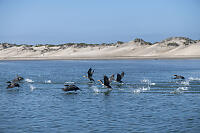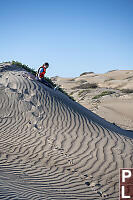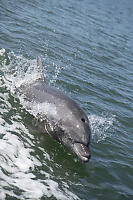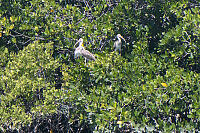
Cabo San Lucas

 It sure is
great to be in Mexico!
It sure is
great to be in Mexico!
Welcome to Mexico! Spring Break is a
good window to travel for us - not too hot in the tropical
destinations and still cold at home. We would normally go to
Hong Kong, but there is a wedding in the fall and we didn't see
ourselves going twice. We looked around at options and Cabo
San Lucas bubbled up to the top for reasonable price and low
effort - Helen wanted a week of all inclusive stay.

Trying to
pick an all inclusive having never been somewhere before is
tricky. Having two kids, we are looking for a specialized kind
of room with three beds, ideally in at least two bedrooms.
Many resorts are dominated by rooms with a single bed and the few
family appropriate rooms seem to sell out quickly. Resorts
with three beds at reasonable price turned out to be a very short
list so I picked based on the menus in the restaurants.
Our resort was built in a number of phases and is currently building
out the "Timeshare" phase, but thankfully they weren't pushing the
timeshare angle hard. Our resort doesn't actually have beach
access - the beach is rocky and the current can apparently be really
strong. I was surprised that the lack of beach access didn't
really bother either kid. If you followed the tides, it might
actually be a good place for snorkeling (A snorkel tour by boat once
unloaded very close to shore) but it's hard to risk things like that
when you are on vacation.

Close to our building was a number of tennis courts but Pickle ball
seamed to be the sport played down here. You could sign out a
court and rackets for two hours so we played a few games once the
sun was low on the horizon.
Magdelana Bay
There are three large lagoons on the West
Coast on Baha where grey whales come to have their babies and hang
out for the winter. The closest to Cabo is Magdelana Bay and
we found an overnight tour that would take us up to see the
whales. It's a long van ride up (there were 8 guests and 2
guides in our tour) but we made it to the bay in the early
afternoon to go whale watching.



We were out in the boat by about 3:30 and
out first stop was actually just across the bay. The bay is
surrounded by sand dune islands and there is a spot where fish
waste is dumped. Birds are often there taking in the free
food, but the coyotes have also figured out this is a good place
for a free meal. As our boat touched down on the sand, the
coyote decided now would be a good time to leave. Given that
they live on an island made out of sand, surrounded by Ocean,
these animals must be good at conserving water.

We drove for kilometers trying to find grey whales, but had no
luck. Apparently even a few days ago there were a dozen plus
mothers and calves in this bay, but the whales don't post a
schedule and they were gone. This is an El Nino year and a
lot of regular animal migrations such as the whale sharks in La
Paz are off their schedule. We drove north of the entrance
to they bay and found a large group of bottlenose dolphins (or
they found us) and the played around our boat for a while.
We are limited by the sun so as they evening got closer, we turned
around and headed back to town.

We had a stop off on the sand dune islands and went for a walk in
the sand. We found small collections of shells in the sand
which made very little sense to me - had someone dropped these off
before?




We got back to the dock, just as
the sun hit the horizon.

This dock and landing
area is meant to hold a lot of traffic. Sadly, it was almost
all empty. Perhaps a week ago when the whales were here, this
would be busy but on the other hand it might have just been over
developed and it's never busy. Hard to know.
The next morning we went out to try and find any whales outside of
the lagoon area. The captain tells us that the Moms and
babies generally stay in the lagoons but there are often more
whales just outside of the lagoons. The water outside of the
barrier islands is significantly rougher and our little boat was
kicked around as we went out looking for whales. Any time we
slowed down, birds caught up with us, hoping we would be throwing
away fish bits.
We eventually gave up and headed back to the lagoons. We
found a pod of Bottlenose dolphins that liked to follow our boat
(and rode the bow wave for a bit)





We drove through some mangrove forests on the way back and then
came into port.



We had a long drive to get back to Cabo San Lucas - we arrived
just after 7pm. A quick Uber back to our hotel and we made
our 8pm dinner reservations!
Shopping in Cabo San Lucas
Our resort is a few km from town, but our
resort has a shuttle bus that runs every two hours. There is
a large marina in Cabo that seems to be the epicenter of tourist
fleecing which includes a large mall. Our resort had a
number of "sister restaurants" included in the meal plan so we
stopped in for lunch and a walk around.
Claira did actually do some shopping - she found a silver pendant
with a bright blue opal inlay. We almost ripped off the
jewlery store - I had Peso's in my wallet so while we negotiated
in USD, I accidentally converted as CAD (12:1) instead of USD
(16:1). The jewelry shop worker figured it out later and
came out to find us as we walked back. My bad - we paid the
difference.
Birding around San Jose Del Cabo "Estuary"
Before I left, I found a company doing
nature tours of the Cabo San Lucas/San Jose Del Cabo area.
They have a variety of tours but need at least two people to sign
up before they run a tour. I was lucky to get a third spot
on a Sunday morning trip to the Estuary in San Jose Del Cabo - the
same place that was one fire when we first flew in on this
trip. Pick up was 6:45am at our hotel and we filled a small
Nissan. The two other birders were also guys - a binocular
birder from Alaska and a photographer birder from the
Midwest. I brought a tripod because I get tired of carrying
my camera all morning.
Our first stop was the estuary which is actually more like an
oasis - fresh water happens to come out of the ground here just
before the ocean. There isn't much circulation but the
wading birds didn't seem to mind.
The estuary is an intersection between palm trees, fresh water
ponds and beach. Our guide has been to this location so many
times that she knows which birds to find in which trees.
The pond side grasses are their own habitat. Our guide
spotted a few Lapis Lazuli - a bird we get in Vancouver.
Surprise to me - these birds are in their winter plumage so they
don't look like the breeding plumage I've seen before.
We also got our first Baha penisnula endemic - the Beldings
Yellowthroat.
The water itself is another habitat - there were more than a dozen
egret in the grasses and more birds in the water foliage.
We talked from the pond area to the beach/ocean side of the
estuary. There were Turkey Vulture in circulating and an
American Kestral looking for a snack.




We got back in the car and drove to a
different part of the marsh. Our guide knew two spots to
find two more Baha endemics - Xantus's Hummingbird and the Gray
Thrasher. Again, our guide knew to the tree where to spot
these birds.
I was dropped off at the resort by 11:30am with lots of time for
the rest of my day. On the way back to the room, I noticed
some iguana's sunning themselves on the rocks. I thought
they might be invasive but doing some research when I got back, I
found out these lizards may have been introduced by the first
nations people that lived in Baha thousands of years ago.

When you first leave the airport at San Jose Del Cabo, the first
thing you are thinking is "wow, is the ground transportation
situation there designed to rip off tourists (we pre-booked a
suburban at a good price). The second thing you are thinking
is "wow, there are a lot of really great cactus out in those
fields!" I kept meaning to take some photos of them but the
resort is landscaped. One morning I went for a walk to less
developed field near by and took some photos of the cactus.
There is a large cactus that catches your eye - the "Mexican Giant
Cactus". These tall cactus often have holes from woodpeckers
and woody like lower parts. You can see some buds near the
top where they flower.
When I started walking around in the bush and it turns out there
is a bunch of different kinds of cactus growing out here. I
found two distinct species immediately - Chain-link Cholla and
Galloping Cactus - both species that try to cover large
areas. I wasn't expecting so much diversity - If there was a
nature trail and more time, I'm sure there is a lot here to
explore.
All good trips come to an end and I really didn't spend enough
time taking photos of the resort. Perhaps a reason to go
back another time!


Tags: Mexico(18), cactus(5), statue(3), sunset(2), dolphin(2), drink(2)
People: Nara(9), Claira(7), John(2)
From: John Harvey Photo > Trips out of the Country > Cabo San Lucas
Last Modified Wednesday, April 24th, 2024 at 21:00:53 Edit
Copyright and Contact Information.

 It sure is
great to be in Mexico!
It sure is
great to be in Mexico!

 It sure is
great to be in Mexico!
It sure is
great to be in Mexico!























